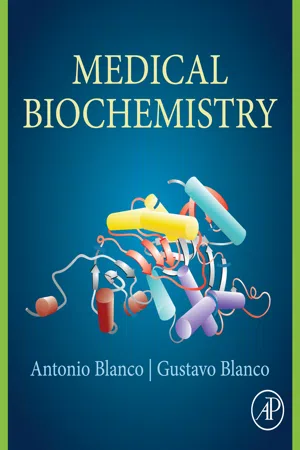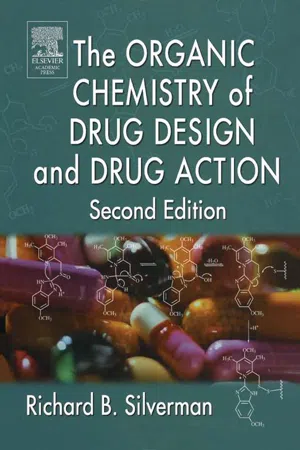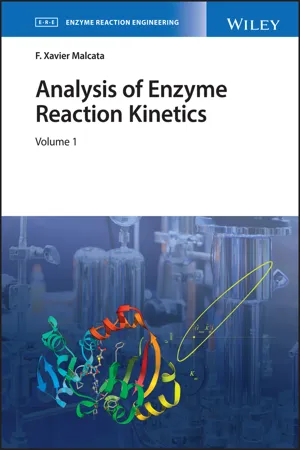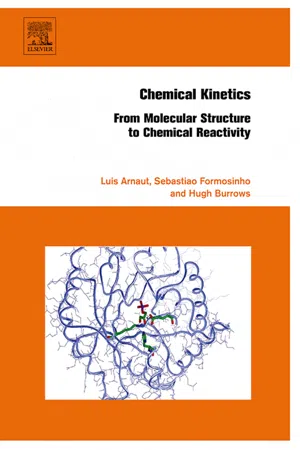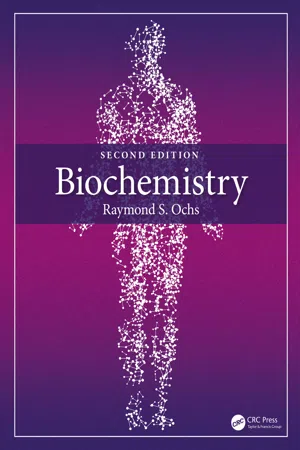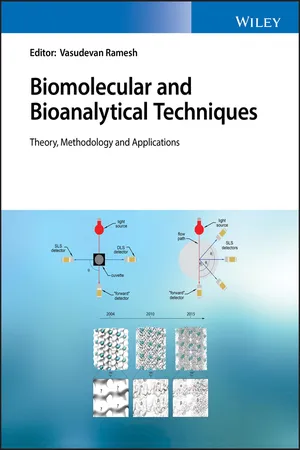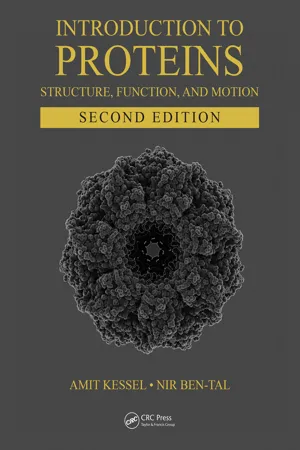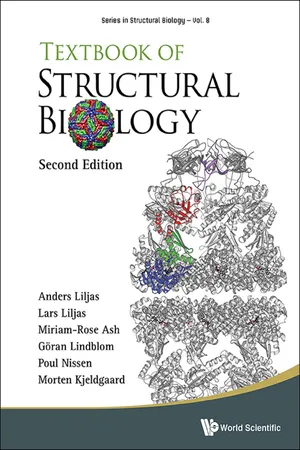Chemistry
Enzyme Catalyzed Reaction
Enzyme-catalyzed reactions are chemical reactions that are facilitated by enzymes, which are biological catalysts. Enzymes speed up the rate of a reaction by lowering the activation energy required for the reaction to occur. They do this by binding to the reactant molecules and bringing them into close proximity, allowing the reaction to proceed more rapidly.
Written by Perlego with AI-assistance
Related key terms
Related key terms
1 of 4
Related key terms
1 of 3
12 Key excerpts on "Enzyme Catalyzed Reaction"
- eBook - ePub
- Antonio Blanco, Gustavo Blanco(Authors)
- 2017(Publication Date)
- Academic Press(Publisher)
Countless chemical reactions take place at a given time in every living being. Many of them transform exogenous substances, which come with the diet, to obtain energy and the basic materials that will be used for the synthesis of endogenous molecules.Biochemical transformations are performed at a remarkable fast rate and with great efficiency. To reproduce them in the laboratory, these reactions would need extreme changes in temperature, pH, or pressure to take place; these changes are not compatible with cell survival. Under normal physiological conditions (37°C for warm-blooded organisms, pH near neutrality, and constant pressure), most of the reactions would proceed very slowly or may not occur at all. It is the presence of catalysts that allow chemical reactions in living beings to occur with great speed and under the mild conditions that are compatible with life.Enzymes are biological catalysts
A catalyst is an agent capable of accelerating a chemical reaction without being part of the final products or being consumed in the process. In biological media, macromolecules called enzymes act as catalysts.As any catalyst, enzymes work by lowering the reaction activation energy (A e ) (see p. 152). Enzymes are more effective than most inorganic catalysts; moreover, enzymes show a greater specificity of effect. Usually inorganic catalysts function by accelerating a variety of chemical reactions, whereas enzymes catalyze only a specific chemical reaction. Some enzymes act on different substances, but generally, these are compounds with similar structural characteristics and the catalyzed reaction is always of the same type.The substances that are modified by enzymes are called substrates .The specificity of enzymes allows them to have high selectivity to distinguish among different substances and even between optical isomers of a compound. For example, glucokinase, an enzyme that catalyzes d -glucose phosphorylation, does not act on l - eBook - ePub
A Study of Enzymes
Enzyme Catalysts, Kinetics, and Substrate Binding
- Stephen A. Kuby(Author)
- 2019(Publication Date)
- CRC Press(Publisher)
Chapter 1Historical Introduction, Theories of Enzyme Catalysis, and some Elementary Considerations of Enzyme Kinetics
I. Introduction
Any understanding of other branches of biochemistry ultimately depends, to a large degree, on some knowledge of the nature, properties (both physical and chemical), and actions of the enzymes, which in turn are responsible for the rate of chemical changes which occur in all living organisms. The myriad of reactions and chemical pathways involved in the intermediary metabolism of protein, fat, and carbohydrate and the intricate chemical reactions concerned with the energetics of the cell are mediated through protein catalysts. Many physiological processes such as muscular contraction, blood clotting, excretion, de-toxication, digestion, etc. are intimately linked with the chemistry of the cell, which invariably hinge on enzymatically catalyzed reactions. To quote Dixon,9 “Life depends on a complex network of chemical reactions brought about by specific enzymes, and any modification of the enzyme pattern may have far-reaching consequences for the living organism …”Enzymes are biocatalysts and as such their function is to influence the rates of chemical reactions. If they act as true catalysts, not the chemical equilibria; they may increase the rate of a particular chemical reaction, but ideally they do not influence the final equilibrium concentrations of reactants and products. However, in several notable cases where investigations were made under conditions where the enzyme concentration was not catalytic, but on the contrary, stoichiometric with respect to the substrate, the final state of the system was shown to be influenced by the enzyme protein concentration. Thus, the enzyme molecule exerts its effective catalytic function by participating directly in the reaction as if it were a reactant. In general, however, where concentrations of enzymes are employed which are several orders of magnitude below that of the substrate(s), the enzyme approaches a true catalyst in nature, and, under these conditions, influences only the rates of chemical reactions and not the final equilibrium state. - Richard B. Silverman(Author)
- 2012(Publication Date)
- Academic Press(Publisher)
Chapter 4 Enzymes Publisher Summary This chapter discusses the role of enzymes as catalysts, mechanisms of enzyme catalysis, coenzyme catalysis, and enzyme therapy. Enzymes are natural proteins that catalyze chemical reactions. Most enzymes are soluble and found in the cytosol of cells. They interact with substrates to form enzyme–substrate complexes, thereby transforming the substrates into products. Enzymes function by lowering transition state energies and energetic intermediates and by raising the ground state energy. The transition state for an enzyme-catalyzed reaction is a high-energy state with a lifetime of about 10 -13 sec, the time for one bond vibration. Once the substrate binds to the active site of the enzyme, there are a variety of mechanisms that the enzyme can utilize to catalyze the conversion of the substrate to product. Some enzymes are useful as drugs, and such enzymes have therapeutic utility to catalyze hydrolytic reactions. The use of genetic engineering techniques to produce altered active enzymes has enhanced the use of enzymes as drugs- eBook - ePub
- F. Xavier Malcata(Author)
- 2023(Publication Date)
- Wiley(Publisher)
1 Introduction1.1 Basic Concepts
Enzymes are the functional units of cell metabolism; these globular proteins with catalytic features possess high activity toward their substrates, at mild operating conditions – which makes them particularly attractive to support clean technologies of chemical processing. Because of the decreasing trend in cost of manufacture of enzymes from microbial sources, those biocatalysts are now available for industrial purposes at higher and higher quantities – and with higher and higher purities, at affordable prices. Hence, enzymes have enjoyed a remarkable growth in associated knowledge, owing to their relevant contributions to such widespread activities as brewing, fruit juice clarification, dry and detergent cleaning, and analytical determinations.As catalysts, enzymes bring about increases in the rate of biochemical reactions without undergoing permanent chemical change themselves; however, such an efficiency usually requires interaction between enzyme and substrate molecules via formation of intermediates with chemical identity. On the other hand, the reactions they catalyze are far from instantaneous – yet the time they take to occur depends on the pathway followed by enzymes to accelerate them. Therefore, the usefulness of rate expressions relating the evolution in concentration of substrate(s) with time – based on postulated intermediates, should reflect the best balance between simplicity and accuracy toward bioprocess engineering at large. The first step is obviously reactions encompassing a single substrate – or run at conditions that mimic a single substrate; multisubstrate enzymatic reactions will thus be left for later discussion.Despite its lack of general applicability to enzyme‐catalyzed reactions due to the underlying simplifying assumptions, unisubstrate rate expressions have conquered a status of reference – and are accordingly useful to compare performance between enzymes in general. The (relative) simplicity in mathematical form of the said rate expressions is probably their major asset – coupled to their mutual resemblance, in terms of asymptotic behaviors predicted and underlying chemical meaning of the very few kinetic parameters at stake. To fully grasp their impact and provide a better scientific framework, a historical perspective is put forward – and further refinements are mentioned, for the sake of completeness. - eBook - ePub
Chemical Kinetics
From Molecular Structure to Chemical Reactivity
- Luis Arnaut, Hugh Burrows(Authors)
- 2006(Publication Date)
- Elsevier Science(Publisher)
14Enzymatic Catalysis
Publisher Summary
This chapter provides a brief description of enzymatic catalysis. Enzymes are the best catalysts known. They mediate a vast array of chemical transformations in all living organisms and do so very efficiently under mild conditions. Most enzymatic mechanisms of catalysis have ample precedents in organic catalytic reactions. Yet reactions that are very fast in the presence of enzymes, become extremely slow in their absence, and some have half-lives approaching the age of the Earth. Enzymes are not only good in their efficiency but are also remarkable for their specificity. Each enzyme usually catalyses one specific reaction, and sometimes, only one specific reactant, called substrate, is converted into products. All known enzymes are proteins. They are made of covalently linked amino acids residues that form very long, unbranched chains. Sometimes the mechanism of enzyme catalysis involves more than one enzyme–substrate complex, such as chymotrypsin, which is one of the most-studied enzymes; it can act as an esterase and a protease, because the chemical mechanisms of ester and amide hydrolases are almost identical.Enzymes are the best catalysts known. They mediate a vast array of chemical transformations in all living organisms and do so very efficiently under mild conditions. Most enzymatic mechanisms of catalysis have ample precedents in organic catalytic reactions. Yet reactions that are very fast in the presence of enzymes, become extremely slow in their absence, and some have half-lives approaching the age of the Earth. For example, the half-life for the spontaneous decarboxylation of amino acids is 1100 million years, but in the presence of arginine decarboxylase, the rate constant of the catalysed reaction is in the vicinity of 100-1000 sec−1 [1] . This, as many other enzyme-catalysed reactions, demonstrates the excellent kinetic efficiency of these catalysts. In general, enzymes produce rate enhancements that range from 107 -fold to 1019 - eBook - ePub
- Raymond S. Ochs(Author)
- 2021(Publication Date)
- CRC Press(Publisher)
S enforces specificity for the catalyzed reaction.FIGURE 6.2 Energy of activation in uncatalyzed and catalyzed reactions. On the left is the high energy intermediate of an uncatalyzed reaction between substrate and product. On the right, an enzyme-catalyzed reaction shows an additional high-energy but stable region, the intermediate enzyme–substrate complex (ES). The enzymatic reaction course has higher reaction barriers on either side; the highest barrier that defines the Eact is lower than that of the uncatalyzed reaction.The chemical transformations of the substrate on the enzyme surface proceed as they would in nonenzymatic processes (e.g., oxidation, proton transfer, or electron rearrangement). Enzymatic reactions are orchestrated with precision. The orientation of the substrate with ancillary groups – or even other substrates – benefits from selective binding to a specific region of the enzyme called the active site. The intermediates symbolized here (i.e., ES) will later be fleshed out in chemical terms. For now, our focus is on how the reaction rate changes as the concentration of the substrate is varied.Box 6.1 Activation Energy and Murphy’s LawThe concept of activation energy can be made intuitive by dispelling a common myth known as “Murphy’s Law” which states that “if anything can go wrong, it will”. While declaring this law generates a cynical acquiescence in listeners, it is in fact wrong – one of the philosophical insights of chemistry. A more accurate law is: “most things can go wrong, but don’t”.The more stable state of a building is a pile of bricks rather than the very orderly arrangement of the structure, yet we hardly fear an imminent collapse while we are inside. This is because it would take a wrecking ball – a large investment of extra energy – to reduce the building to a more stable arrangement. Similarly, virtually all reactions that can proceed to a more stable form nonetheless require an input of great energy to get them going. In the molecular world, we need to think of this as providing increased movement of molecules (rotations, vibrations, translations) before the reaction can occur. Thus, even though the final state may be more stable than the initial state, activation energy is always required. Murphy was apparently an incautious investigator who rushed to publication. - eBook - ePub
- T. D. H. Bugg(Author)
- 2012(Publication Date)
- Wiley(Publisher)
reaction catalysed by the enzyme, being the production of a single regio- and stereo-isomer of the product. Both are properties which are highly prized in synthetic reactions used in organic chemistry: enzymes are able to do both.3.2 A thermodynamic model of catalysisA catalyst may be defined as a species which accelerates the rate of a chemical reaction whilst itself remaining unchanged at the end of the catalytic reaction. In thermodynamic terms, catalysis of a chemical reaction is achieved by reducing the activation energy for that reaction, the activation energy being the difference in free energy between the reagent(s) and the transition state for the reaction. This reduction in activation energy can be achieved either by stabilisation (and hence reduction in free energy) of the transition state by the catalyst, or by the catalyst finding some other lower energy pathway for the reaction.Figure 3.4 Free energy profiles for (A) an acid-catalysed reaction and (B) an enzyme-catalysed reaction.Figure 3.4 illustrates the free energy profile of a typical acid-catalysed chemical reaction which converts a substrate S to a product P. In this case an intermediate chemical species SH+ is formed upon protonation of S. If the conversion of SH+ to PH+ is “easier” than the conversion of S to P, then the activation energy for the reaction will be reduced and hence the reaction will go faster. It is important at this point to define the difference between an intermediate and a transition state: an intermediate is a stable (or semi-stable) chemical species formed during the reaction and is therefore a local energy minimum , whereas a transition state is by definition a local energy maximum - eBook - ePub
Biomolecular and Bioanalytical Techniques
Theory, Methodology and Applications
- Vasudevan Ramesh, Vasudevan Ramesh(Authors)
- 2019(Publication Date)
- Wiley(Publisher)
two molecules of A combining to form some product). The reaction initially proceeds rapidly, but falls significantly as the concentration of A approaches zero. Enzyme kinetics have a greater level of complications. These arise because the enzyme catalyst is a highly complex molecule and undergoes structural changes on a very rapid (nanosecond to microsecond) timescale. The enzyme reaction usually occurs on a microsecond to second timescale and includes many steps (including substrate binding, the formation of intermediates and the release of products). Consequently, the process by which the enzyme speeds up the reaction must be considered to understand the nature of the catalytic process and the relevant kinetic parameters. The nature of enzyme catalysis is to provide a reaction pathway with a lower free energy barrier than the uncatalysed reaction (Figure 9.3). Most enzyme‐catalysed reactions take place at a very slow rate in the absence of catalysis. All reactions must pass through one or more transition state(s) that are maxima in free energy. The rate of the reaction will be determined by the proportion of substrate molecules that are able to access this state. In order to access the enzyme‐catalysed intermediate state, the substrate must first bind to the enzyme. As binding of substrate to the enzyme is usually a fast, reversible event, the rate of these reactions is far too rapid to be determined except with specialist instruments designed to collect rate data on millisecond timescales (see Advanced Methods, Section 9.6). Figure 9.3 Schematic of enzyme catalysis. The uncatalysed reaction (red) has to overcome a large free energy barrier to reach the transition state (TS). A simple example enzyme catalysed reaction (blue) provides a reaction route at a lower free energy. The free energy barrier is lower, allowing more molecules to react - eBook - ePub
Enzyme Kinetics: Catalysis and Control
A Reference of Theory and Best-Practice Methods
- Daniel L. Purich(Author)
- 2010(Publication Date)
- Elsevier(Publisher)
It then follows that one cannot reasonably expect that the principles of physical organochemical can alone adequately account for the energetics of an enzyme-catalyzed reaction. Moreover, because the catalyst and reactant combine and jointly pass over the catalytic landscape, the observed energetics that are indicated in nearly all enzymatic reaction progress diagrams are those for the catalyzed sequence: E + S (E·S 1) (E·S 2) (E·S 3) ···· (E·X) ‡ ···· (E·P 3) (E·P 2) (E·P 1) E + P, and NOT for the uncatalyzed sequence: S S 2 S 3 ···· X ‡ ···· P 3 P 2 P. Point 10: For multi-step reactions, each reacting species is connected to the next by a pair of rate constants defining the barrier heights for forward and reverse directions. Multi-stage mechanisms of the type shown immediately above are characterized by a succession of transition states, each defining the energetic barriers between successive reacting species. Whenever a transition state is of such low free energy that cannot be rate-determining, such a transition-state is said to be kinetically insignificant. A nagging unresolved issue is whether mechanistic inferences predicted solely on the basis of uncatalyzed reactions are valid for enzyme-catalyzed reactions. For example, can the principles of uncatalyzed organic chemical reactions be used to accurately predict the magnitudes of kinetic isotope effects for enzyme-catalyzed reactions? 3.11. THERMODYNAMIC PRINCIPLES Although kinetics and thermodynamics represent different chemical disciplines, kinetic processes are inevitably subject to thermodynamics constraints. A brief summary of the principles of equilibrium thermodynamics therefore is appropriate to close this chapter on the foundations of chemical kinetics. Also included is the formalism introduced by the American physical chemist Robert Alberty for biochemical thermodynamics. Finally, the basics of non-equilibrium thermodynamics are summarized. 3.11.1 - eBook - ePub
Introduction to Proteins
Structure, Function, and Motion, Second Edition
- Amit Kessel, Nir Ben-Tal(Authors)
- 2018(Publication Date)
- Chapman and Hall/CRC(Publisher)
] .As explained in the introduction to this chapter, chemical reactions proceed from reactant(s) to product(s) through a sequence of intermediates, which differ from one another in their chemistry, configuration, and free energy. Like other catalysts, enzymes accelerate chemical reactions by lowering the energy barrier associated with the transition state — a reaction intermediate with the highest free energy. However, in contrast to other simple catalysts like metals, most enzymes are highly specific to the types of reactions they accelerate, and to the substrates on which they act. This specificity is achieved thanks to the ‘active site ’, a pocket-like depression in the structure of the enzyme, to which the substrate binds and in which the chemical reaction is accelerated. The active site fulfils two major functions[145 ]:- Substrate bindingthe active sites of enzymes may bind a variety of substrates, including small molecules (e.g., monosaccharides or amino acids), moderate-size molecules (e.g., short peptides) and even macromolecules (e.g., proteins and polysaccharides) [ 145] . Accordingly, active sites may vary greatly in size, with sizes typically ranging between 400and 2,000Ao 2Ao 2[146 ]. Substrate binding is mediated through multiple noncovalent interactions between different parts of the substrate and chemical groups in the active site (Figure 9.22). These interactions render the binding specific, which accounts for the selectivity of enzymes to their natural (cognate) substrates (see below). The binding interactions also provide the energy used for keeping the substrate inside the active site, which accounts for the affinity between the two. The interactions mainly involve active site amino acids. Indeed, the side chains of binding residues offer a diverse set of chemical groups: nonpolar (linear or branched), hydroxyl, thiol, amine, amide, carboxylate, imidazole, indole, phenol, and guanidinium[147 ](Figure 9.23; see also Figure 2.5 and Table 2.1 in Chapter 2 ). Some active sites interact with their substrates via additional chemical groups, which may be components of small organic molecules (e.g., nucleotides, small carbohydrate units, and lipids), metals, or other inorganic species (e.g., water) (see Section 9.3 below). As explained in Chapters 2 and 8 , these molecular adducts, which in enzymes are usually referred to as ‘cofactors ’, may be permanently attached ‘prosthetic groups ’ or transiently bound ‘coenzymes ’[148
- eBook - ePub
Reversible Ligand Binding
Theory and Experiment
- Andrea Bellelli, Jannette Carey(Authors)
- 2017(Publication Date)
- Wiley(Publisher)
7 ). Thus we feel that graphical representations specific to the enzyme field are out of scope. We refer the interested reader to specialized enzymology treatises (e.g., Cornish Bowden, 1995; Palmer, 1985).8.4 Enzymatic Catalysis of Reversible Reactions
The reactions catalyzed by enzymes can often be reversible, and tend to an equilibrium condition where both the reagent(s) and the product(s) are significantly populated. In these cases the enzyme accelerates progress to the same equilibrium condition the system would reach at a much lower rate in its absence. Study of this type of reaction is of great theoretical interest, but rarely has practical relevance, because the experiments are preferentially designed to determine initial velocities, under conditions far removed from equilibrium. We shall consider here the rate equation for enzyme‐catalyzed reversible reactions, and the case of one‐way enzymes.A simple case of a reversible reaction catalyzed by enzymes is isomerization. For example, the reader may be interested in revisiting the classical characterization of the forward and backward reactions of triose‐phosphate isomerase by Plaut and Knowles (1972). The simplest reaction scheme is as follows:where the number of internal steps (in square brackets) may be variable. An isomerization reaction catalyzed by an enzyme can proceed by a quite complex mechanism, with several intermediate species. For this example we shall consider only the simplest possible mechanism, in which a single intermediate is considered; thus, we group the terms [ES <==> EP] of the above scheme under the fictitious species ES*. - eBook - ePub
- Anders Liljas, Lars Liljas;Miriam-Rose Ash;G?ran Lindblom;Poul Nissen;Morten Kjeldgaard(Authors)
- 2016(Publication Date)
- WSPC(Publisher)
8
Enzymes
Enzymes are proteins that catalyze biochemical reactions without being consumed, and are able to perform the same reaction over and over again. They have a wide range of catalytic properties and are classified on that basis (hydrolases, ligases, reductases, oxidases and so on).Enzymes are usually large molecules, but only a small fraction of the amino acid residues participate in the catalysis. The area of an enzyme where the binding of the substrate(s) and the catalysis occurs is called the active site. The active sites are frequently located in some sort of depression or cavity in the structure of the enzyme. Sometimes cofactors (like metal ions) or coenzymes (like NADH) are bound in the active site and participate in the reaction.Many enzymes are highly specific for their substrates. This is generated by complementarities in shape of the substrate and the active site. The complementarity may also include the charge, polarity and hydrophobicity relationship between substrate and active site. Due to this complementarity enzymes are often highly stereospecific, substrates with the wrong hand may not be able to bind. Different models have been used to describe the interaction between enzyme and substrate. An early description is the “lock and key model” which illustrates the complementarity but not how the enzyme may function.Enzymes are flexible molecules like all proteins. The dynamics involve atomic oscillations, side chain reorientation and movements of main chain or of whole domains. This dynamic character is essential for enzyme activity. During binding and catalysis residues of the active site or large parts of the enzymes can undergo conformational changes just like the substrate going through chemical changes. One model that emphasizes the conformational changes of enzyme as well as substrate is called “induced fit” (Figure 8.1
Index pages curate the most relevant extracts from our library of academic textbooks. They’ve been created using an in-house natural language model (NLM), each adding context and meaning to key research topics.
Explore more topic indexes
Explore more topic indexes
1 of 6
Explore more topic indexes
1 of 4
